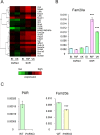Pregnane X receptor knockout mice display aging-dependent wearing of articular cartilage
- PMID: 25749104
- PMCID: PMC4352085
- DOI: 10.1371/journal.pone.0119177
Pregnane X receptor knockout mice display aging-dependent wearing of articular cartilage
Abstract
Steroid and xenobiotic receptor (SXR) and its murine ortholog, pregnane X receptor (PXR), are nuclear receptors that are expressed at high levels in the liver and the intestine where they function as xenobiotic sensors that induce expression of genes involved in detoxification and drug excretion. Recent evidence showed that SXR and PXR are also expressed in bone tissue where they mediate bone metabolism. Here we report that systemic deletion of PXR results in aging-dependent wearing of articular cartilage of knee joints. Histomorphometrical analysis showed remarkable reduction of width and an enlarged gap between femoral and tibial articular cartilage in PXR knockout mice. We hypothesized that genes induced by SXR in chondrocytes have a protective effect on articular cartilage and identified Fam20a (family with sequence similarity 20a) as an SXR-dependent gene induced by the known SXR ligands, rifampicin and vitamin K2. Lastly, we demonstrated the biological significance of Fam20a expression in chondrocytes by evaluating osteoarthritis-related gene expression of primary articular chondrocytes. Consistent with epidemiological findings, our results indicate that SXR/PXR protects against aging-dependent wearing of articular cartilage and that ligands for SXR/PXR have potential role in preventing osteoarthritis caused by aging.
Conflict of interest statement
Figures





References
-
- Synold TW, Dussault I, Forman BM. The orphan nuclear receptor SXR coordinately regulates drug metabolism and efflux. Nat Med. 2001;7: 584–590. - PubMed
-
- Tabb MM, Sun A, Zhou C, Grün F, Errandi J, Romero K, et al. Vitamin K2 regulation of bone homeostasis is mediated by the steroid and xenobiotic receptor SXR. J Biol Chem. 2003;278: 43919–43927. - PubMed
Publication types
MeSH terms
Substances
Associated data
- Actions
Grants and funding
LinkOut - more resources
Full Text Sources
Other Literature Sources
Medical
Molecular Biology Databases
Research Materials
Miscellaneous

